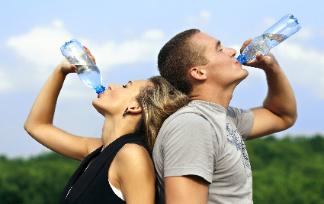- Phone: 800-492-1252
- Fax: 440-368-3569
- E-mail: info@spartanwatertreatment.com
Commercial ozone generators are often utilized in bottled water production equipment. Spartan Environmental Technologies supplies industrial ozone generators and ozone water treatment systems for a variety of applications including bottled water production processing. For more information call us at 800-492-1252, e-mail us at info@spartanwatertreatment.com, or follow the information below.

Ozone is used in a variety of drinking or potable water treatment applications including the treatment of bottled water. In fact, ozone water treatment is the most frequently used disinfection process in water bottling today. It has proven to be a safe and effective method of producing high quality water. Spartan’s equipment is well suited for bottled water applications and has been used in a number of production facilities. Ozone can disinfect the water, the bottling equipment, the bottle, the air above the water and the sealed cap of the bottle. Other benefits of ozone water treatment in bottling include improved taste, elimination of odor, and improved shelf life. Additionally, it leaves no unpleasant odor or taste since ozone decomposes into oxygen, which is often not accomplished with other disinfectants.
An effective ozone water treatment process needs to have a good ozone contact system. This system must efficiently transfer the ozone gas into the water and then provide a sufficient contact time for ozone to react with the micro organisms and chemicals in the water. The mixing of ozone with water ozone is usually done with an ejector or venturi. These systems can achieve transfer efficiencies of 85-95%. The system should allow enough time for the ozone to act on the constituents of the water to insure proper disinfection and removal of unwanted chemicals. The amount of ozone required is determined by the ozone demand of the water. Any constituent that can be oxidized by ozone will consume ozone must be satisfied while leaving an excess residual. The excess residual will insure that all pathogens have been inactivated if sufficient contact time has been provided.
Typically, testing is needed to define the ozone demand of specific water. Besides the specific constituents of the water, other factors impact ozone demand. These include: pH, temperature, filler design, operating procedures, etc. Process control for ozonation will focus on the proper dosage of ozone into the water to achieve the necessary residual without adding excess ozone to the water. A typical configuration will involve a contact tank with a recirculation loop. Ozone is injected into the recirculation loop and the tank provides the proper contact time for the reaction of the ozone with the water. The system will have a level control and vent. The vent will allow excess ozone gas released from the water to pass into an ozone destroyer (decomposer). The decomposer prevents excess ozone from entering the atmosphere of the bottling plant.
The Spartan SPARTOX ozone water treatment system provides an integrated package for ozonation of bottled water on a single skid. Learn more about our SPARTOX products.
As noted above, the ozone has two functions in the bottle water treatment process: disinfection and chemical oxidation.
Ozone is a broad spectrum disinfectant which can treat viruses, bacteria and protozoa such as cryptosporidium. The water disinfection process should be applied downstream of all other water treatment and water conditioning of the source water and just prior to the bottling step of the bottled water production. The ozone disinfection of bottled water is expected to treat the smaller microorganisms with dissolved ozone concentrations in the range of 0.1 – 0.4 mg/l. Learn more about ozone water disinfection.
Chemical oxidation in bottled water treatment is often directed at taste and odor compounds. Learn more about the actual mechanisms of how ozone reacts with organic and inorganic compounds.

The Food and Drug Administration (FDA) has responsibility over the bottled water in the USA. The International Bottled Water Association (IBWA) standards are based on FDA and EPA regulations.
“A substance added to the food (and water is a food) may be marketed without a regulation if it is one which is considered as Generally Recognized As Safe (GRAS) by experts qualified by scientific training and experience to evaluate safety”. In 1982, the FDA classified ozone as GRAS for use as a disinfectant for bottled water up to a residual dissolved ozone concentration of 0.4 mg/l.
The FDA has recognized ozone treatment to be a Good Manufacturing Practice (GMP) for the bottled water industry. The minimum ozone treatment for GMP is 0.1 mg/l ozone in water in an enclosed system for at least 5 minutes.
The Department of Labor and its agency, the Occupational Safety and Health Administration (OSHA) has the regulatory authority over the allowed maximum ozone concentration levels in the atmosphere of work places, such as, water bottling plants. The maximum ozone concentration permitted in those places is 0.1 ppm by volume.
The recommended practice is the installation of an ambient air ozone safety system consisting of an ozone monitor coupled to the on/off control of the ozone generator and of the room’s exhaust air system. When the ozone concentration exceeds the allowed preset level, the safety system shuts off the ozone generator and activates the air exhaust system. As noted above, in order to meet the above OSHA regulatory requirement, the ozone treatment system should be a closed system with a vent for the off-gas to outdoors at roof top level through an ozone decomposer. The filler should be hooded or enclosed with an exhaust to the outdoors.
The IBWA offers a manual to its members called the “IBWA Plant Technical Reference Manual”. This manual covers among others guidelines, standards and OSHA recording and reporting requirements.
For more information call us at 800-492-1252 or e-mail us at info@spartanwatertreatment.com.